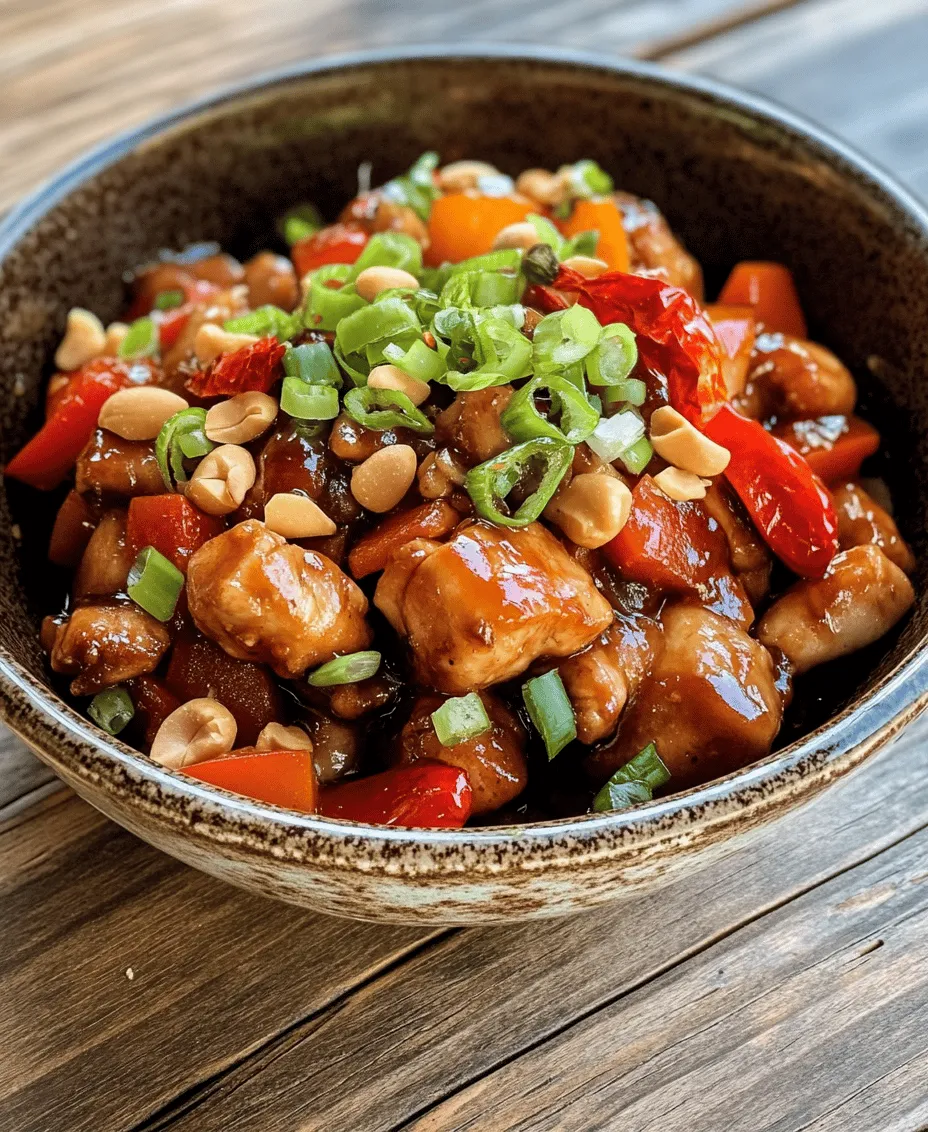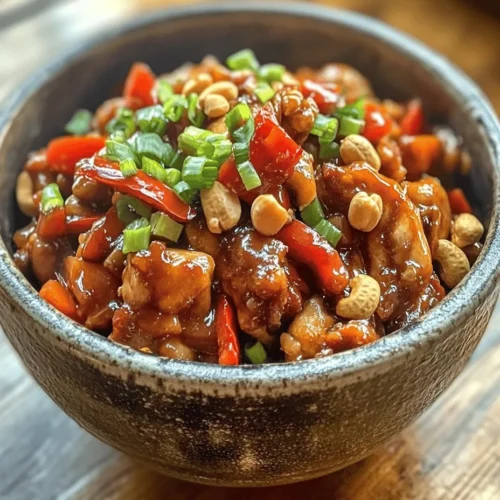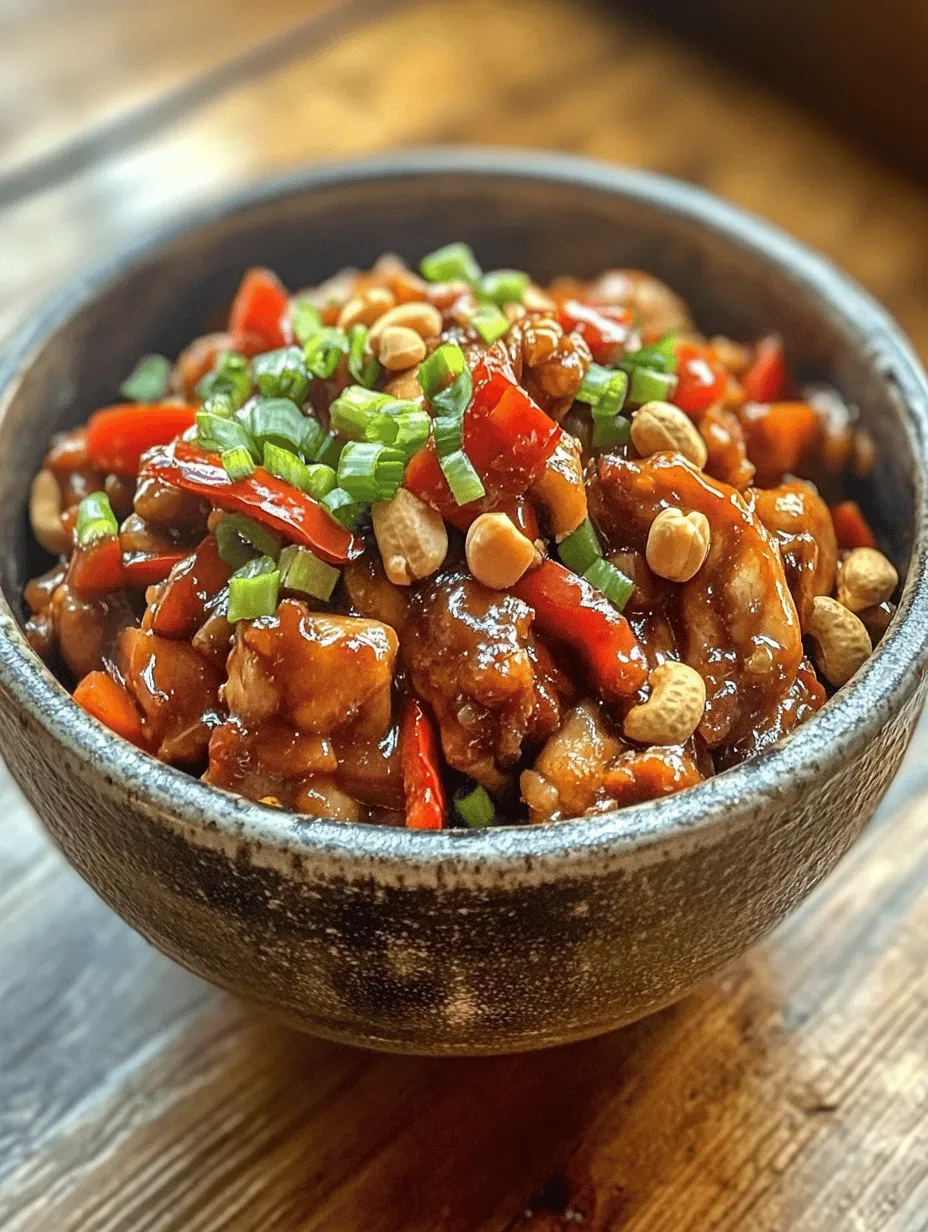Kung Pao Chicken Delight is a beloved classic in Asian cuisine, renowned for its vibrant flavors and satisfying textures. This dish combines tender chicken pieces, colorful vegetables, and a delightful blend of spices, making it a staple in many households and restaurants around the world. What sets Kung Pao Chicken apart is its unique balance of spiciness, sweetness, and umami, creating an explosion of flavor in every bite. Whether you are an experienced cook or just starting out, this recipe will guide you through the steps needed to create a delectable version of this iconic dish right in your own kitchen.
A Brief History of Kung Pao Chicken
Originating from the Sichuan province of China, Kung Pao Chicken has a rich history that dates back to the Qing Dynasty. It is named after Ding Baozhen, a governor of Sichuan who held the title “Kung Pao,” which translates to “Palace Guardian.” The dish was originally prepared with diced chicken, peanuts, and vegetables, and was often enjoyed by the elite. Over the years, it has evolved and adapted, spreading beyond its origins to become a favorite in Chinese restaurants worldwide.
The appeal of Kung Pao Chicken lies not only in its flavor but also in its versatility. The dish can be easily modified to suit different palates, whether you prefer a milder version or one with an extra kick of heat. Additionally, it is typically served with rice, allowing the bold flavors to shine while balancing the overall meal.
In this article, we will delve into the intricacies of making Kung Pao Chicken Delight, exploring the essential ingredients, preparation methods, and cooking techniques that will elevate your culinary skills. Prepare to embark on a journey filled with delightful flavors and aromas!
Understanding the Ingredients
To create the perfect Kung Pao Chicken, it is crucial to understand the core components that contribute to its rich flavor profile. Each ingredient plays a significant role in building the dish’s identity, from the chicken marinade to the flavorful sauce and stir-fried vegetables. Let’s break down these elements:
Breakdown of Chicken Marinade Ingredients
The marinade is vital for ensuring the chicken is tender and flavorful. Here are the key ingredients you’ll need:
– Soy Sauce: This fermented sauce is a cornerstone of Asian cooking, providing depth and umami to the chicken. It enhances the overall flavor while also contributing to the dish’s signature savory notes.
– Rice Vinegar: A critical component in the marinade, rice vinegar tenderizes the chicken while imparting a mild acidity that balances the dish’s richness. It also helps to enhance the flavors of the other ingredients.
– Cornstarch: This ingredient plays a dual role; it not only aids in tenderizing the chicken but also helps create a velvety texture when stir-fried. The cornstarch forms a protective coating around the chicken, which helps retain moisture during cooking.
The Flavorful Sauce: Ingredients and Their Functions
The sauce is where the magic happens in Kung Pao Chicken. It ties all the flavors together and adds complexity to the dish. Here’s what you’ll need:
– Soy Sauce: As a base for the sauce, soy sauce provides saltiness and a deep flavor, complementing the other ingredients.
– Brown Sugar: This ingredient introduces a hint of sweetness that balances the savory elements of the dish. The caramel notes of brown sugar enhance the overall flavor profile.
– Hoisin Sauce: Known for its rich and slightly sweet taste, hoisin sauce adds depth and complexity to the Kung Pao Chicken, making it more indulgent.
– Sesame Oil: A few drops of sesame oil infuse the dish with aromatic notes, elevating the overall flavor and adding a touch of authenticity.
Stir-Fry Essentials: Vegetables and Nuts
The vegetables and nuts used in Kung Pao Chicken not only add texture but also enhance the visual appeal of the dish. Here are the essentials:
– Red Bell Pepper: This vibrant vegetable provides a pop of color and a slight crunch, complementing the tender chicken and peanuts.
– Peanuts: A traditional element in Kung Pao Chicken, peanuts add a delightful crunch and nutty flavor. They are a crucial component that defines the dish.
– Chilies: Dried chilies are essential for adding spice. Depending on your heat preference, you can adjust the quantity to achieve the desired level of heat.
– Aromatics: Fresh garlic and ginger serve as the backbone of flavor in the dish. They enhance the overall aroma and provide a fragrant base that elevates the taste of Kung Pao Chicken.
Step-by-Step Guide to Making Kung Pao Chicken Delight
Now that we’ve covered the ingredients, let’s dive into the step-by-step process of creating Kung Pao Chicken Delight. This guide will provide detailed instructions for each stage of the cooking process, ensuring that you achieve the best results.
Marinating the Chicken: Importance and Techniques
Marinating the chicken is a crucial step that should not be overlooked. Here’s how to do it effectively:
1. Combine the Marinade Ingredients: In a mixing bowl, combine soy sauce, rice vinegar, and cornstarch. Mix well to ensure the cornstarch dissolves completely.
2. Add the Chicken: Cut the chicken into bite-sized cubes and add it to the marinade. Make sure each piece is evenly coated to maximize flavor absorption.
3. Marinate: Allow the chicken to marinate for at least 30 minutes. For optimal results, marinating for a few hours or even overnight in the refrigerator is recommended. This will enhance the flavor and tenderness of the chicken.
4. Time Management: While the chicken is marinating, use this time to prepare the other ingredients. Chop the vegetables, measure out the sauce ingredients, and have everything ready for a smooth cooking process.
Crafting the Sauce: Techniques for Perfect Balance
A well-balanced sauce is essential for a successful Kung Pao Chicken. Here’s how to create it:
1. Combine Sauce Ingredients: In a separate bowl, mix soy sauce, brown sugar, hoisin sauce, and a small amount of cornstarch with water to create a slurry. This slurry will help thicken the sauce during cooking.
2. Whisk Thoroughly: Ensure that all ingredients are well combined to achieve a smooth consistency. Adjust the sweetness and saltiness to your taste by adding more sugar or soy sauce if necessary.
3. Set Aside: Once your sauce is ready, set it aside until you are ready to stir-fry the chicken. This allows the flavors to meld together.
The Art of Stir-Frying: Tips for Perfecting Technique
Stir-frying is a quick and efficient cooking method that locks in flavors and maintains the texture of the ingredients. Follow these tips to master the technique:
1. Heat the Oil: In a large wok or skillet, heat a generous amount of oil over medium-high heat. The oil should shimmer but not smoke. This is crucial for achieving a good sear on the chicken.
2. Cook the Chicken: Add the marinated chicken to the hot oil in a single layer. Avoid overcrowding the pan, as this can lead to steaming rather than searing. Allow the chicken to cook undisturbed for a few minutes to develop a golden-brown crust.
3. Stir-Fry in Batches: If you have a large amount of chicken, consider cooking it in batches to ensure even cooking. Remove the cooked chicken from the pan and set it aside while you prepare the remaining batches.
4. Add the Aromatics: Once the chicken is cooked, add minced garlic and ginger to the pan. Stir-fry for about 30 seconds until fragrant, but be careful not to burn them.
5. Incorporate Vegetables: Next, add the chopped vegetables and dried chilies to the pan. Stir-fry for an additional 2-3 minutes until the vegetables are tender-crisp.
With these steps, you are well on your way to creating a delightful Kung Pao Chicken that is sure to impress your family and friends. The combination of tender chicken, crunchy vegetables, and rich flavors will make this dish a standout at any meal.
Stay tuned for the next part of this article, where we will explore the finishing touches and serving suggestions for Kung Pao Chicken Delight, ensuring that your culinary masterpiece is both beautiful and delicious!

Importance of Not Overcrowding the Wok
When preparing your Kung Pao Chicken Delight, one essential technique to keep in mind is the importance of not overcrowding the wok. This is crucial for achieving that perfect stir-fry texture and flavor. Overcrowding causes the ingredients to steam rather than fry, which can lead to a soggy dish that lacks the vibrant colors and crisp textures you desire.
To prevent this, work in batches if necessary. Start by cooking the chicken first until it’s golden brown and cooked through. Once you’ve removed the chicken from the wok, add the vegetables in another batch. This not only ensures each ingredient is cooked properly but also allows the flavors to meld beautifully without being diluted by excess moisture.
Combining Flavors: Integrating Chicken, Vegetables, and Sauce
Once your chicken is cooked and the vegetables are ready, it’s time to bring everything together. Start by returning the cooked chicken to the wok, followed by the sautéed vegetables. This is the moment when the magic happens; the combination of tender chicken and crisp vegetables is the heart of Kung Pao Chicken Delight.
Now, pour the prepared sauce over the mixture. The key here is to mix everything thoroughly, ensuring that each piece of chicken and vegetable is coated evenly. Use a spatula to fold the ingredients gently; this ensures that the sauce envelops every bite without breaking down the vegetables.
Techniques for Ensuring Even Coating of Sauce
To achieve an even coating of sauce on your Kung Pao Chicken, there are a few techniques you can employ. First, ensure the sauce is at room temperature before adding it to the hot ingredients. A cold sauce can cause the temperature of your stir-fry to drop, leading to uneven cooking.
Second, pour the sauce in a circular motion around the edges of the wok rather than directly on the chicken and vegetables. This technique allows the hot surface of the wok to help caramelize the sauce, giving it a richer flavor while ensuring that it evenly distributes over all ingredients. Stir continuously for about 2-3 minutes, allowing the sauce to thicken slightly and cling to the chicken and vegetables.
Timing for Adding Peanuts and Green Onions
Timing is key in Kung Pao Chicken Delight, especially when it comes to adding the finishing touches like peanuts and green onions. These ingredients not only add flavor but also texture and visual appeal to the dish.
Add the roasted peanuts during the last minute of cooking. This allows them to warm up and absorb some of the sauce’s flavor without losing their crunch. If you add them too early, they may become soft and lose their delightful texture.
As for the green onions, they should be added just before serving. Simply sprinkle them over the top of your dish after removing it from the heat. This preserves their bright color and crispness, adding a fresh bite that perfectly complements the savory flavors of the Kung Pao Chicken.
Serving Suggestions for Kung Pao Chicken Delight
Creating a Complete Meal Experience
To elevate your Kung Pao Chicken Delight to a complete meal experience, consider pairing it with complementary side dishes. Here are some recommendations that will enhance your dining experience.
Recommended Side Dishes
1. Steamed Rice: The ultimate companion for Kung Pao Chicken, steamed rice acts as a blank canvas that absorbs the bold flavors of the dish. Opt for jasmine or basmati rice for their fragrant notes that pair beautifully with the savory sauce.
2. Noodles: If you’re looking for a heartier meal, consider serving Kung Pao Chicken over stir-fried noodles. This adds an additional layer of texture and flavor, making it a filling option for your dinner table.
Presentation Tips
The presentation of your Kung Pao Chicken can significantly enhance the dining experience. Here are some plating techniques to consider:
1. Plating Techniques for an Appetizing Look: Use a large, shallow bowl or plate to display your Kung Pao Chicken. Start by adding a generous scoop of rice or noodles as a base, then pile the chicken and vegetable mixture on top. This creates height and visual interest.
2. Garnishing Ideas Using Fresh Ingredients: Finish your dish with a sprinkle of sesame seeds or sliced red chili for a pop of color. Fresh cilantro leaves can also be used as a garnish, adding a hint of freshness and a visually appealing touch.
Cultural Context and Variations of Kung Pao Chicken
Exploring the Dish’s Rich History and Global Adaptations
Kung Pao Chicken has a rich history that dates back to the late Qing Dynasty. Originating from Sichuan province in China, the dish was named after Ding Baozhen, a governor of Sichuan who was affectionately called “Kung Pao” or “Palace Guardian.” The original recipe included diced chicken, peanuts, and various spices, infused with the bold flavors characteristic of Sichuan cuisine.
Its Roots in Sichuan Cuisine and Regional Variations
Sichuan cuisine is renowned for its use of bold flavors, particularly the heat from Sichuan peppercorns and chili peppers. Traditional Kung Pao Chicken features these ingredients prominently, creating a dish that is spicy yet balanced by the sweetness of the sauce.
Regionally, variations of Kung Pao Chicken exist throughout China and beyond. In some areas, the dish may incorporate different proteins such as shrimp or tofu, while others may use a variety of vegetables. The spice levels may also differ dramatically, with some versions being milder or more intense, depending on local preferences.
The Evolution of the Dish Over Time
As Kung Pao Chicken spread beyond China, it underwent various adaptations. In Western countries, for example, it is often made sweeter and less spicy to cater to different palates. The use of bell peppers and onions instead of traditional Sichuan vegetables is also common in American versions of the dish.
Common Variations Across Different Regions
The beauty of Kung Pao Chicken lies in its flexibility. You can find versions that highlight different ingredients based on regional tastes. For instance, in Taiwan, you might encounter a version that incorporates sweet and sour elements, while in some parts of the U.S., cashews may replace traditional peanuts for a different texture.
Differences in Spice Levels and Ingredient Choices
The spice levels in Kung Pao Chicken can vary widely. If you enjoy a kick, opt for more Sichuan peppercorns and dried chilies. Conversely, if you prefer a milder version, you can reduce the amount of spice or even omit certain ingredients altogether.
Vegetarian and Vegan Adaptations of the Recipe
For those looking to enjoy Kung Pao Chicken while adhering to vegetarian or vegan diets, there are plenty of adaptations available. Substitute chicken with tofu or tempeh, which can absorb flavors beautifully when marinated and sautéed. Similarly, you can replace the sauce’s traditional oyster sauce with mushroom sauce to maintain that umami depth.
Nutritional Profile of Kung Pao Chicken Delight
Analyzing the Health Aspects of the Dish
Kung Pao Chicken Delight is not only delicious but can also be a nutritious option for your meals. Let’s break down the key nutritional components:
Breakdown of Macros: Protein, Carbs, and Fats
– Protein: With chicken as the star ingredient, Kung Pao Chicken is an excellent source of protein. A typical serving can provide around 25 grams of protein, making it a fulfilling choice for those looking to meet their protein needs.
– Carbohydrates: The carbohydrates in this dish primarily come from the vegetables and any grains served alongside. If paired with brown rice or whole-grain noodles, you can enhance the nutritional profile with more fiber.
– Fats: The fats in this dish mainly come from peanuts and any oil used for cooking. While peanuts add healthy fats, it’s crucial to use them in moderation to balance overall fat intake.
Health Benefits of Chicken and Peanuts
Chicken is a lean meat that provides essential nutrients, including B vitamins, iron, and zinc. Peanuts, on the other hand, are rich in healthy fats, protein, and antioxidants. They also contain resveratrol, known for its potential health benefits.
Nutritional Benefits of the Vegetables Used
The vegetables in Kung Pao Chicken, such as bell peppers and zucchini, contribute essential vitamins and minerals. They’re high in fiber, which aids digestion and contributes to overall health.
Balancing Flavor and Nutrition
To create a healthier version of Kung Pao Chicken without sacrificing flavor, consider reducing the amount of oil used in cooking and opting for low-sodium soy sauce. Increasing the vegetable content can also enhance the nutritional profile, providing a colorful array of vitamins while keeping the dish satisfying.
Conclusion: Bringing Kung Pao Chicken Delight to Your Kitchen
Kung Pao Chicken Delight is more than just a meal; it is an experience that brings together flavors, textures, and cultural history. This recipe invites you to explore the intricacies of Asian cooking while providing a satisfying dish that can be enjoyed by all. With clear instructions and an understanding of the ingredients, you can confidently recreate this classic at home, making it a staple in your culinary repertoire. Enjoy the journey of flavors, and let Kung Pao Chicken Delight become a cherished part of your dining experience.


